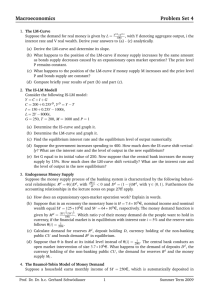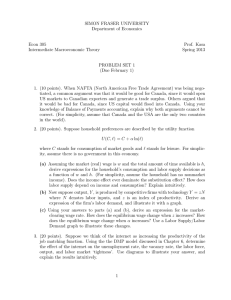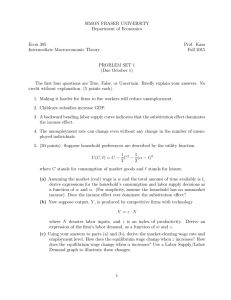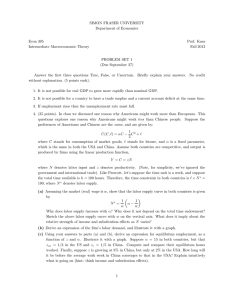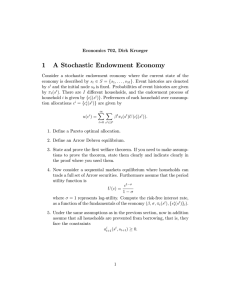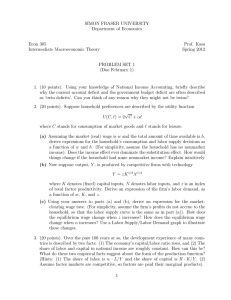SIMON FRASER UNIVERSITY Department of Economics Econ 808 Prof. Kasa
advertisement
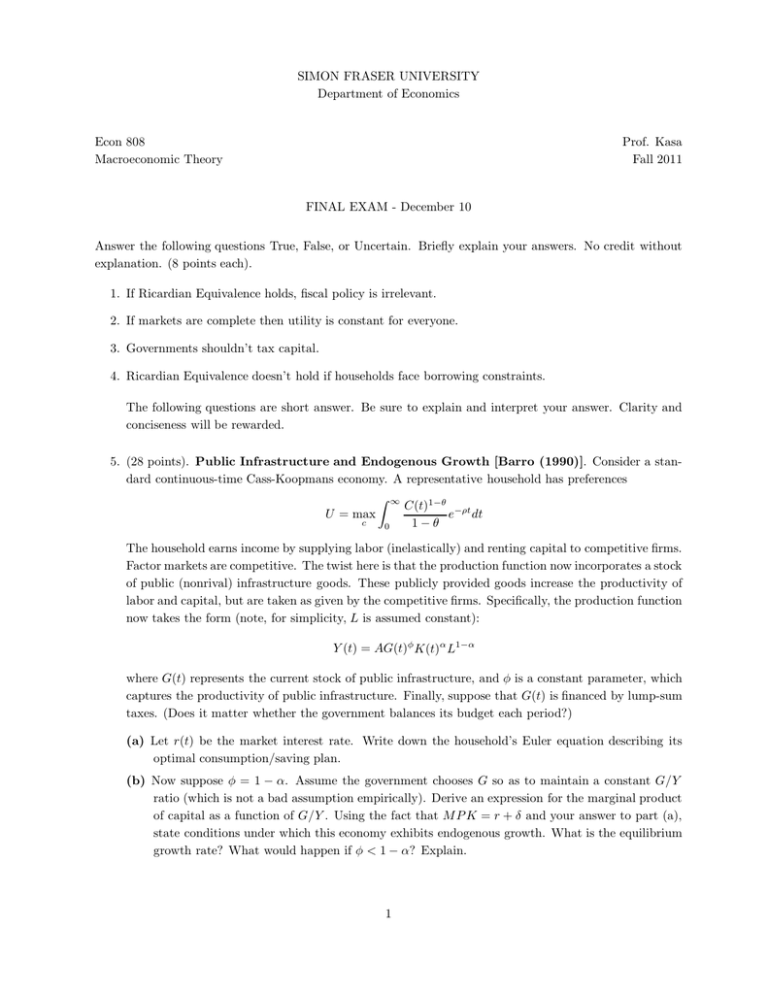
SIMON FRASER UNIVERSITY
Department of Economics
Econ 808
Macroeconomic Theory
Prof. Kasa
Fall 2011
FINAL EXAM - December 10
Answer the following questions True, False, or Uncertain. Briefly explain your answers. No credit without
explanation. (8 points each).
1. If Ricardian Equivalence holds, fiscal policy is irrelevant.
2. If markets are complete then utility is constant for everyone.
3. Governments shouldn’t tax capital.
4. Ricardian Equivalence doesn’t hold if households face borrowing constraints.
The following questions are short answer. Be sure to explain and interpret your answer. Clarity and
conciseness will be rewarded.
5. (28 points). Public Infrastructure and Endogenous Growth [Barro (1990)]. Consider a standard continuous-time Cass-Koopmans economy. A representative household has preferences
Z ∞
C(t)1−θ −ρt
e dt
U = max
c
1−θ
0
The household earns income by supplying labor (inelastically) and renting capital to competitive firms.
Factor markets are competitive. The twist here is that the production function now incorporates a stock
of public (nonrival) infrastructure goods. These publicly provided goods increase the productivity of
labor and capital, but are taken as given by the competitive firms. Specifically, the production function
now takes the form (note, for simplicity, L is assumed constant):
Y (t) = AG(t)φ K(t)α L1−α
where G(t) represents the current stock of public infrastructure, and φ is a constant parameter, which
captures the productivity of public infrastructure. Finally, suppose that G(t) is financed by lump-sum
taxes. (Does it matter whether the government balances its budget each period?)
(a) Let r(t) be the market interest rate. Write down the household’s Euler equation describing its
optimal consumption/saving plan.
(b) Now suppose φ = 1 − α. Assume the government chooses G so as to maintain a constant G/Y
ratio (which is not a bad assumption empirically). Derive an expression for the marginal product
of capital as a function of G/Y . Using the fact that M P K = r + δ and your answer to part (a),
state conditions under which this economy exhibits endogenous growth. What is the equilibrium
growth rate? What would happen if φ < 1 − α? Explain.
1
(c) Let’s now consider the optimal choice of G. Continue to assume that φ = 1 − α. Consider a
social planner that simultaneously selects paths of C(t) and G(t) so as to maximize the present
discounted value of the household’s utility, subject to the economy-wide resource constraint
K̇ = Y − C − δK − G
Write down the planner’s Hamiltonian (either current or present-value, your choice) and derive
the first-order optimality conditions. Prove that the optimal path of G(t)/Y (t) is constant, and
derive an expression for the optimal G/Y ratio. How does it compare to observed data?
(d) Suppose the government financed G by levying either a constant labor-income tax or a constant
consumption tax. Would the above results change? Why or why not? What about a tax on total
income (including capital income)?
6. (25 points). Comovements Between the Stock and Bond Markets [Barsky (1989)]. Consider
a simple 2-period Lucas asset pricing model. A representative household can invest in either a riskfree bond or an equity claim. The equity claim yields a stochastic second-period endowment of Ỹ2.
The first-period endowment is known, and is equal to Y1 . The good is nonstorable, and as in Lucas,
equilibrium aggregate consumption is equal to the aggregate endowment each period. Suppose that
the reprentative household’s prefernces are given by
"
#
C11−γ
C21−γ
U=
+ βE
1−γ
1−γ
The household maximizes this subject to the constraint
Ct + R−1
f,t Bt + pt St ≤ At
where At+1 = Bt + (pt+1 + Yt+1 )St . In these expressions, Rf,t represents the (real) risk-free rate, Bt
is the household’s holdings of bonds, pt is the stock price, and St is the household’s holdings of equity
claims.
(a) By deriving the first-order conditions for Bt and St , write down a pair of Euler equations that
describe the solution to the household’s consumption/portfolio problem.
(b) By imposing the equilibrium conditions C1 = Y1 and C2 = Y2 , derive expressions for the equilibrium risk-free rate and the equilibrium stock return. (Hints: (1) Remember, since the world ends
in period-2, it must be the case that p2 = 0, (2) Remember, the return on an asset is its payoff
divided by its price. Given Hint 1, that means the stock return, Rt, just equals Y2 /p1.)
(c) To simplify your answer to part (b), suppose the stochastic dividend, Y2 is log-normally distributed.
That is, log Y2 is normally distributed with mean, µ and variance σ2 . (Therefore, log E(aY2 ) =
a2 µ + 12 a2σ2 , where a is any arbitrary constant). Using these assumptions and facts, derive
expressions for log[E(R)] and log Rf (i.e., the log of the expected stock return and the log of the
risk-free rate.
(d) Under what conditions will stock and bond returns be positively correlated? Under what conditions will they be negatively correlated? Empirically, the correlation between stock and bond
returns seems to switch. Could this model explain a time-varying correlation? If not, what
changes to the model would be required?
7. (25 points). Risk-Sharing [Wilson (1968)]. Consider a finite group I of individuals. Income for
each individual, yti (st ), is determined each period as a function of the history of events up to and
2
including time t, st = [s0 , s1, · · · st ]. Denote aggregate income by Yt (st ) ≡
utility function for individual i is given by
E0
∞
X
β t u(ct(st )) =
∞ X
X
P
i∈I
yti (st ). Assume the
β t u(ct(st ))πt(st )
t=0 st
t=0
where πt (st ) is the unconditional probability of history st . Finally, suppose their are no ‘frictions’ (e.g.,
the state st is observable and there are no commitment/enforcement problems).
(a) Write out the Pareto problem for this economy, for given Pareto weights {λi}. Prove that optimal
consumption for each individual depends only on aggregate income in that period (i.e., controlling
for Yt(st ), individual consumption does not exhibit history dependence).
(b) Let’s now try to generalize this result. Suppose the planner now has access to a ‘storage technology’, meaning that if an amount St (st−1 ) ≥ 0 was stored in period t − 1, then in period t
an amount (1 + rt(st ))St (st−1) is available in period t (in addition to that period’s aggregate
endowment, Yt (st )). Prove that a similar result to that in part (a) continues to apply, except now
P
we must condition on aggregate consumption Ct(st ) = i∈I cit (st ).
(c) Now let’s specialize this result to derive some explicit sharing rules. Suppose preferences take the
CARA form
−1
ui(c) = i exp{−γ i c}
γ
Prove that individual consumption takes the form: cit = ai Ct + bi, where ai and bi are constants,
P i
P i
with
a = 1 and
b = 0. How does the distribution of γ i affect ai and bi ? Explain the
intuition.
(d) Now suppose preferences take the CRRA form
ui(c) =
c1−σ
1−σ
where the coefficient of relative risk aversion is the same for everyone. Prove that optimal conP i
sumption takes the form: cit = φiCt, where the constants satisfy
φ = 1. How do the constants
depend on the Pareto weights λi ?
(e) Briefly discuss how the sharing rules in parts (c) and (d) could be decentralized.
3
